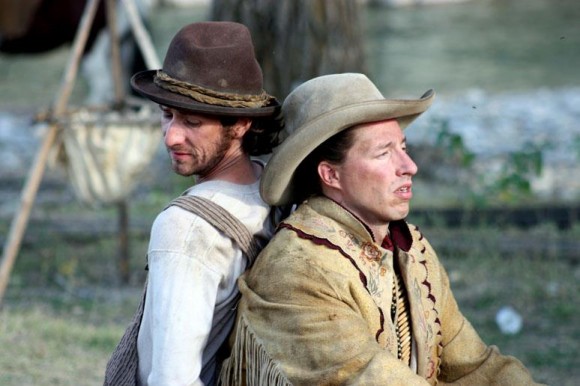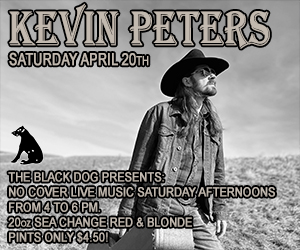FILM: Ornery buffalo roam, tobacco tastes funny in A Legend of Whitey
Posted on November 30, 2011 By Mike Ross Culture, Film, The Latest
 “You like FUBAR? How about a gay Western?”
“You like FUBAR? How about a gay Western?”
This is the offer from Dave Lawrence, who is perhaps better known as “Terry” in FUBAR and FUBAR II, on the release of his new film “A Legend of Whitey,” beginning a weeklong run at the Garneau Metro Cinema on Friday. It is his directorial debut.
With the action set in 1880 Alberta, Lawrence and Paul “Deaner” Spence play a couple of numbskulls – big surprise – who run afoul of a rancher who is in deep denial that his son might be gay. Unlike conventional Old West yarns where heroes generally prevail with brains against superior brawn, every single character in A Legend of Whitey is dumb, Lawrence says. It’s not quite Back to the FUBAR Part III: Hosers of the Old West, but the spirit is there.
“Since some of the comedy is in the similar stupid vein, you might look at this as the lineage of Terry and Dean, their great, great, great, great grandfathers – perhaps,” says Lawrence. “But we were trying to get away from the FUBAR stuff, just to do some different characters. Growing up, we were fans of the Western genre. What would be my fantasy? To make a Western.”
It’s a comedy-Western, a satire, so one immediately assumes Blazing Saddles would be the huge inspiration. Wrong. It’s Little Big Man and Brokeback Mountain. And there ends our list of major Westerns with gay content.
“My wife took me to see Brokeback Mountain and I was like, OK, I’ll go check it out,” Lawrence says. “And when we left, I said, you know what? The movie was fine. But If I had been told I was going to go to a romantic Western, whether it was gay or not, I wouldn’t be so sure I wanted to go. That’s not a genre I’m really interested in: Romantic Western. But then I just heard these rednecks who were angry at Brokeback Mountain: ‘I’m never going to watch that!’ They were afraid, they were mad at the movie. So I thought, man, there must’ve been some guys back in 1880 who were gay and had to deal with that sort of stuff. So that was an inspiration, and because Brokeback ruffled some feathers, it was another reason to say: Let’s go there.”
 Where they went specifically was Longview, Alberta, home of Ian Tyson and some of the most beautifully “Western” scenery in the province, where cast and crew in the fall of 2009 endured 20 days of hardships not unlike those suffered by their flea-bitten ancestors – trudging across the Chinook-blasted Albertan steppes with the ornery titular white buffalo in tow. Long story. Lawrence rues the fact that he broke at least two of the laws of movie-making that moviemakers break all the time: Never star in the film you’re directing – and never work with animals. The buffalo was a problem. The trainer was hurt. The beast also broke out at one point and ran amok, scaring “the shit” out of everybody, Lawrence says.
Where they went specifically was Longview, Alberta, home of Ian Tyson and some of the most beautifully “Western” scenery in the province, where cast and crew in the fall of 2009 endured 20 days of hardships not unlike those suffered by their flea-bitten ancestors – trudging across the Chinook-blasted Albertan steppes with the ornery titular white buffalo in tow. Long story. Lawrence rues the fact that he broke at least two of the laws of movie-making that moviemakers break all the time: Never star in the film you’re directing – and never work with animals. The buffalo was a problem. The trainer was hurt. The beast also broke out at one point and ran amok, scaring “the shit” out of everybody, Lawrence says.
And let’s not even talk about the weather. OK, let’s.
“The temperature dropped 50 degrees over the four weeks. From 35 above to 15 below. The windstorm was pretty crazy. It flipped our kitchen tent and rolled it over the parking lot, crashing everyone’s cars. And they weren’t being paid much anyway and then I’m like, oh yeah, and I fucked up your cars. Amongst other things. There were union issues. Man, it goes on and on.”
The magic of movie making!
Lawrence uses that phrase to remind people that shooting a film is hard labour. We’re talking back-to-back 18-hour days. No time to party. They weren’t wasted every day making FUBAR, either. He says he’s fine with being associated with Terry for the rest of his life, but it is a fictional character – albeit one many Edmonton guys resembled when they were 17 – and “I’m not like that. People are usually disappointed I’m not that in real life. I’ve have people say, ‘can you be more like your character than you?’”
But come on, man. It can’t all be movie magic. You at least smoke lot of weed and drink a lot of beer, don’t you?
“I do, but I guess it’s not enough.”
There’s just one marijuana reference in A Legend of Whitey to support the idea that Deaner and Terry in the 2000s are direct descendents of Luther and William in the 1880s: “My character says, ‘This tobacco tastes different,’ and then we’re looking up at the clouds saying, hey, that cloud looks like an Indian chief.”













